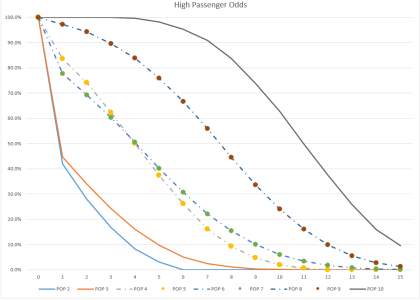You are using an out of date browser. It may not display this or other websites correctly.
You should upgrade or use an alternative browser.
You should upgrade or use an alternative browser.
LBB 3 Tech level
- Thread starter spank
- Start date
Spinward Flow
SOC-14 5K
Fun thing is looking at that graph and realize that the 600 ton Subsidized Liner (Type-M) has accommodations for up to 21 high passengers.
Given the above realities of probabilities for high passenger ticket demand ... pretty much the only (reliable!) way to fill up those staterooms with high passengers is to have a pre-planned route plot in order to declare multiple destinations at each starport stop along the route. So instead of working a single destination per jump, the Subsidized Liner is working multiple destinations per jump and operates on a "rolling basis" between a collection of Population: 8+ worlds, with everything in between being "jump over" territory.
So the Subsidized Liner is basically "picking and choosing" the larger passenger markets (so as to "make it up in volume") and then leave the lower end markets to the free traders and feeder lines working the "smaller" worlds on the map.
Given the above realities of probabilities for high passenger ticket demand ... pretty much the only (reliable!) way to fill up those staterooms with high passengers is to have a pre-planned route plot in order to declare multiple destinations at each starport stop along the route. So instead of working a single destination per jump, the Subsidized Liner is working multiple destinations per jump and operates on a "rolling basis" between a collection of Population: 8+ worlds, with everything in between being "jump over" territory.
So the Subsidized Liner is basically "picking and choosing" the larger passenger markets (so as to "make it up in volume") and then leave the lower end markets to the free traders and feeder lines working the "smaller" worlds on the map.
Considering that it's 21 High/Middle it wouldn't be that hard to fill,Fun thing is looking at that graph and realize that the 600 ton Subsidized Liner (Type-M) has accommodations for up to 21 high passengers.
Given the above realities of probabilities for high passenger ticket demand ... pretty much the only (reliable!) way to fill up those staterooms with high passengers is to have a pre-planned route plot in order to declare multiple destinations at each starport stop along the route. So instead of working a single destination per jump, the Subsidized Liner is working multiple destinations per jump and operates on a "rolling basis" between a collection of Population: 8+ worlds, with everything in between being "jump over" territory.
So the Subsidized Liner is basically "picking and choosing" the larger passenger markets (so as to "make it up in volume") and then leave the lower end markets to the free traders and feeder lines working the "smaller" worlds on the map.
Any planet that is 8+ POP will yield and average of 15 High+Middle passengers.
Throw in a +3 modifier for a POP 8 plus destination, and that climbs to 21.
With a 75% Demand of 12.
So if it's between 2 world of POP 8+ you'll have 15 passengers 75% of the time.
IDK if I buy the multiple destinations approach,
The ticket cost if fixed, regardless of distance.
"Passage is always sold on the basis of transport to the announced destination,
rather than on the basis of jump distance."
So if you take on a Passenger to a destination that is 2 jumps away you're on the hook for 2 rounds of life support, if it's a Middle Passenger you're taking in 8,000 Cr, and paying 4000 Cr for life support.
That's 4,000 Cr profit in 2 jumps for 4 tons of space. But, that same space would make 8,000 Cr hauling 2 trips of cargo.

kilemall
SOC-14 5K
Your critique ignores the following paragraph where it makes clear a jump 3 ticket is one ticket, whereas 3 jump 1s to the same destination is 3 tickets.Considering that it's 21 High/Middle it wouldn't be that hard to fill,
Any planet that is 8+ POP will yield and average of 15 High+Middle passengers.
Throw in a +3 modifier for a POP 8 plus destination, and that climbs to 21.
With a 75% Demand of 12.
So if it's between 2 world of POP 8+ you'll have 15 passengers 75% of the time.
IDK if I buy the multiple destinations approach,
The ticket cost if fixed, regardless of distance.
"Passage is always sold on the basis of transport to the announced destination,
rather than on the basis of jump distance."
So if you take on a Passenger to a destination that is 2 jumps away you're on the hook for 2 rounds of life support, if it's a Middle Passenger you're taking in 8,000 Cr, and paying 4000 Cr for life support.
That's 4,000 Cr profit in 2 jumps for 4 tons of space. But, that same space would make 8,000 Cr hauling 2 trips of cargo.
View attachment 5644
Ok,
that was not the impression I got from reading that.
I guess I got hung up on the first part,
"A jump-3 starship charges the same passage price as a jump-1 starship. The
difference is that a jump-3 ship can reach a destination in one jump, while the
jump-1 ship would take three separate jumps"
and missed:
"(through two intermediate destinations,
and requiring three separate tickets) to reach it."
In which case it would work out well for the operators, but who'd buy two Jump 1 tickets when you could buy one Jump 2?
that was not the impression I got from reading that.
I guess I got hung up on the first part,
"A jump-3 starship charges the same passage price as a jump-1 starship. The
difference is that a jump-3 ship can reach a destination in one jump, while the
jump-1 ship would take three separate jumps"
and missed:
"(through two intermediate destinations,
and requiring three separate tickets) to reach it."
In which case it would work out well for the operators, but who'd buy two Jump 1 tickets when you could buy one Jump 2?
Your critique ignores the following paragraph where it makes clear a jump 3 ticket is one ticket, whereas 3 jump 1s to the same destination is 3 tickets.
Spinward Flow
SOC-14 5K
The answer to that question gets more complicated than what a Referee needs to know/adjudicate for a PC starship (exclusively).In which case it would work out well for the operators, but who'd buy two Jump 1 tickets when you could buy one Jump 2?
If you're really determined to drill down into The Simulation™ ... it's perfectly possible for there to be a condition where 2 starships are going to the same destination at the same and are thus competing for customers in a zero sum game kind of way. In those circumstances, presumably anyone who can't get a single ticket on the J2 ship has to settle for buying two tickets on the J1 ship.
The intermediate destinations explanation is what makes multi-jump travel both possible and economical (for operators and ticket buyers alike).
Far too many people fall into the trap of assuming that ticket prices are calculated per parsec ... which is only true if you're limited to J1. As soon as you get into the realm of J2+, you realize (or don't ...
So if you can reach a destination in 1 jump, you can only sell single tickets to that destination.
If you need to make 3 jumps to reach a destination, you'll be selling three tickets to get to that destination.
In either case, the range/number of parsecs traveled makes no difference.
1J3 = 1 ticket
3J1 = 3 tickets
It's really just that simple.
Anyway,
Back to the horse I was beating.....
After plotting the curves for High Passengers I'm even more convinced that the rolls for Passengers need re-done.
First I'll point out that the curve for 1D-1D is indistinguishable from 2D6-7, So replacing 1D-1D with 2D6-7 just makes sense. It's much clearer for a newbie to read.

Moving on, 2D-2D is very similar to 1D-1D, This means that even though passengers for POP 2 and POP 3 worlds are rolled differently you get very similar results. There are differences, but they are quite small, far less than a +1 DM.

You see the same pattern repeated for 2D-1D and 3D-2D, Very similar results. The max difference is 6% The whole middle of the chart is smashed together. And because each one covers 2 POP brackets; 4&5 and 6&7, fully 55% of all worlds will fall in this range.
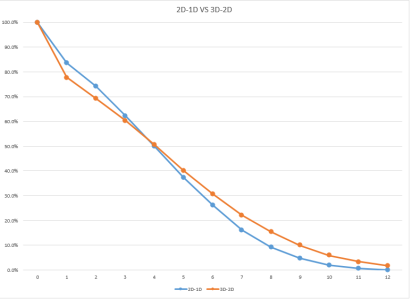
Next up is 3D-2D not much to say on this one, except it is pretty close to 2D6.
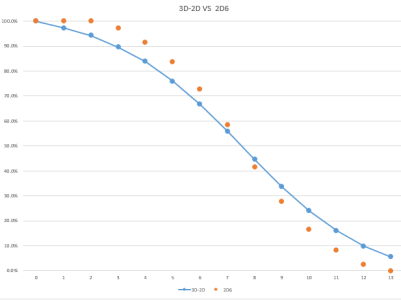
And that leaves POP 10, Which is 3d6. Not much to say on this one

Overall you get a spread like this:
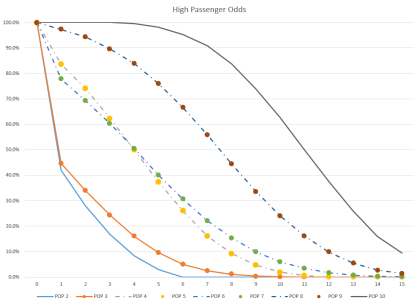
Compare with the rolls for cargo, where each roll is distinct and separate.
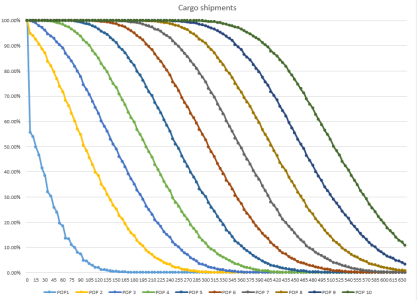
Replacing the passenger rolls with a modified 2D6 roll would both simplify the rolls, and improve the distribution.
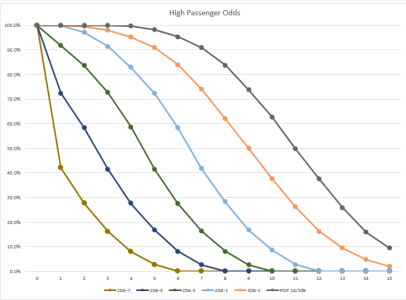
that's my take on it anyway.
Back to the horse I was beating.....
After plotting the curves for High Passengers I'm even more convinced that the rolls for Passengers need re-done.
First I'll point out that the curve for 1D-1D is indistinguishable from 2D6-7, So replacing 1D-1D with 2D6-7 just makes sense. It's much clearer for a newbie to read.

Moving on, 2D-2D is very similar to 1D-1D, This means that even though passengers for POP 2 and POP 3 worlds are rolled differently you get very similar results. There are differences, but they are quite small, far less than a +1 DM.

You see the same pattern repeated for 2D-1D and 3D-2D, Very similar results. The max difference is 6% The whole middle of the chart is smashed together. And because each one covers 2 POP brackets; 4&5 and 6&7, fully 55% of all worlds will fall in this range.

Next up is 3D-2D not much to say on this one, except it is pretty close to 2D6.

And that leaves POP 10, Which is 3d6. Not much to say on this one

Overall you get a spread like this:

Compare with the rolls for cargo, where each roll is distinct and separate.

Replacing the passenger rolls with a modified 2D6 roll would both simplify the rolls, and improve the distribution.

that's my take on it anyway.
Last edited:
You could also give each POP it's own distinct curve rather than making 4-5 and, 6-7 and 8-9 double up.
something like:
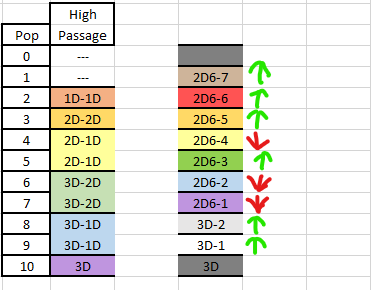
Over all it's a mixed bag. Likely slightly better, because POP 1 gets a a roll, and POP 2 & 3 get slightly better.
But nobody's gonna get rich off these changes. Maybe just go broke slower.
something like:

Over all it's a mixed bag. Likely slightly better, because POP 1 gets a a roll, and POP 2 & 3 get slightly better.
But nobody's gonna get rich off these changes. Maybe just go broke slower.
kilemall
SOC-14 5K
A scenario where you are on one of these low pop planets, merchants have a copy of Spank’s Merchant Prospectus and avoid them like the plague.In which case it would work out well for the operators, but who'd buy two Jump 1 tickets when you could buy one Jump 2?
J1 trader in is the only boat out of system, don’t know when the next one comes through, it probably won’t be a J3, and the marshal might figure out who heisted the grav train. Time to go…
One could homerule per parsec rates and the higher jump ships become more viable to risk smaller pops.
Alternatively, adding a desirability factor, say plus 1D for the jump number -1 for both cargo lots and each category of passenger could give the flavor of fast movers getting preference in a per jump fee RAW mechanic.
TNE had an interesting mechanic that gave a bonus to getting passengers based on character's skills.A scenario where you are on one of these low pop planets, merchants have a copy of Spank’s Merchant Prospectus and avoid them like the plague.
J1 trader in is the only boat out of system, don’t know when the next one comes through, it probably won’t be a J3, and the marshal might figure out who heisted the grav train. Time to go…
One could homerule per parsec rates and the higher jump ships become more viable to risk smaller pops.
Alternatively, adding a desirability factor, say plus 1D for the jump number -1 for both cargo lots and each category of passenger could give the flavor of fast movers getting preference in a per jump fee RAW mechanic.
Service for High passengers,
Legal/Admin for Middle
and Streetwise for Low/Steerage.
TNE had an interesting mechanic that gave a bonus to getting passengers based on character's skills.
Service for High passengers,
Legal/Admin for Middle
and Streetwise for Low/Steerage.
That was originally in LBB7: Merchant Prince (Steward for High Passage, Admin for Middle Passage, Streetwise for Low Passage, Liaison for Minor Cargo) and was carried forward into MegaTraveller then on to TNE.
In many ways, it is like a CRUISE SHIP where the price is PER DAY. Slow or fast ... many stops or few ... it is a PER DAY price to rent the room.So if you can reach a destination in 1 jump, you can only sell single tickets to that destination.
If you need to make 3 jumps to reach a destination, you'll be selling three tickets to get to that destination.
In either case, the range/number of parsecs traveled makes no difference.
1J3 = 1 ticket
3J1 = 3 tickets
It's really just that simple.
Starships just rent rooms in 2 week increments (based on Life Support costs).
One interesting take-away from the combined High-Middle passage odds,
You are more likely to get at least 1 passenger on a POP2 world than you are on a POP3, POP 4, POP5, POP6, POP7 or POP 8 world.
And more likely to get at least 2, 3, or 4 passengers on a POP 2 world than a POP 3 world.
This is largely because the middle passage roll for a POP 2 is 1D6, which yields more results in the region we care about, 1,2,3, and 4 and less results in the negative or zero range. You could fix this by replacing it with 2D6-4, or 2D-1D if you want it to match the rest of the chart.
If you choose the 2D-1D then you'd have 3 POP bracket covered by the same roll, POP 2,3,& 4
Alternately you could make it 1D6-1 which would be the simplest fix.

You are more likely to get at least 1 passenger on a POP2 world than you are on a POP3, POP 4, POP5, POP6, POP7 or POP 8 world.
And more likely to get at least 2, 3, or 4 passengers on a POP 2 world than a POP 3 world.
This is largely because the middle passage roll for a POP 2 is 1D6, which yields more results in the region we care about, 1,2,3, and 4 and less results in the negative or zero range. You could fix this by replacing it with 2D6-4, or 2D-1D if you want it to match the rest of the chart.
If you choose the 2D-1D then you'd have 3 POP bracket covered by the same roll, POP 2,3,& 4
Alternately you could make it 1D6-1 which would be the simplest fix.

Looking at the Cargo numbers for Megatraveller, They are a good bit different.
There is alot less cargo moving in the MT era, Majors lots are 1D6+10 tons instead of 1D6*10 Tons.
So 11 to 16 tons vs 10 to 60 tons.
Minor lots are 1D6+6 tons instead of 1D6*5 tons.
So 6-11 tons instead of 5-30 tons.

Two things I like,

Overall, CT gives much more freight, but the table in MegaTraveller explains the process better.
There is alot less cargo moving in the MT era, Majors lots are 1D6+10 tons instead of 1D6*10 Tons.
So 11 to 16 tons vs 10 to 60 tons.
Minor lots are 1D6+6 tons instead of 1D6*5 tons.
So 6-11 tons instead of 5-30 tons.

Two things I like,
- It is now divided into "Freight" and "Cargo". Freight being paid shipments, and Cargo being speculative.
- It is now much clearer from looking at the table how to roll Freight Lots.

Overall, CT gives much more freight, but the table in MegaTraveller explains the process better.
Just FYI ... MT errata:Looking at the Cargo numbers for Megatraveller, They are a good bit different.
There is alot less cargo moving in the MT era, Majors lots are 1D6+10 tons instead of 1D6*10 Tons.
So 11 to 16 tons vs 10 to 60 tons.
Minor lots are 1D6+6 tons instead of 1D6*5 tons.
So 6-11 tons instead of 5-30 tons.
Page 50, Step 5, Freight and Cargo (correction and clarification): The sentence “If the goods are cargo (carried for a fee of Cr 1,000 per ton...” should read “If the goods are freight (carried for a fee of Cr 1,000 per ton...”
Lot Size: Major Cargos: 1D×10. Minor Cargos: 1D×5. Incidental Cargos: 1D. Lot size is stated in displacement tons. To convert to kiloliters, multiply by 13.5. From the note under Step 3, Freight and Cargo are determined separately in Step 5.
Similar threads
- Replies
- 185
- Views
- 6K
- Replies
- 6
- Views
- 607
- Replies
- 12
- Views
- 3K

